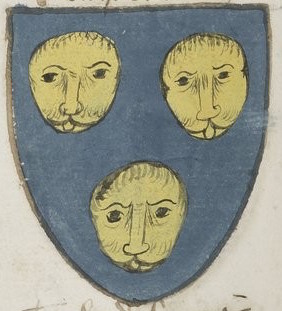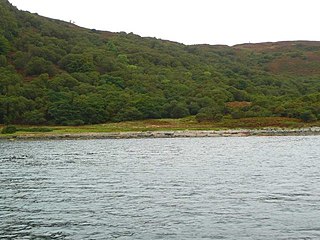
Clan Mackay is an ancient and once-powerful Highland Scottish clan from the far North of the Scottish Highlands, but with roots in the old Kingdom of Moray. They supported Robert the Bruce during the Wars of Scottish Independence in the 14th century. In the centuries that followed they were anti-Jacobite. The territory of the Clan Mackay consisted of the parishes of Farr, Tongue, Durness and Eddrachillis, and was known as Strathnaver, in the north-west of the county of Sutherland. However, it was not until 1829 that Strathnaver was considered part of Sutherland when the chief sold his lands to the Earls of Sutherland and the Highland Clearances then had dire consequences for the clan. In the 17th century the Mackay chief's territory had extended to the east to include the parish of Reay in the west of the neighbouring county of Caithness. The chief of the clan is Lord Reay and the lands of Strathnaver later became known as the Reay Country.

Clan Sutherland is a Highland Scottish clan whose traditional territory is the shire of Sutherland in the far north of Scotland. The chief of the clan was also the powerful Earl of Sutherland, however in the early 16th century this title passed through marriage to a younger son of the chief of Clan Gordon. The current chief is Alistair Sutherland who holds the title Earl of Sutherland.

The McGhee family is an ancient lowland family of Scotland, established as landowners in Galloway since at least the 13th century. Both the Clan Donald and the Clan Mackay claim it as a sept. Historically, however, the Mackays are in fact an offshoot of this family rather than vice versa. The ancient origins of the McGhees are uncertain, though they were probably Gaels from Ireland who took part in the conquest of Galloway between the 9th and 11th centuries. Their property in Kirkcudbrightshire was significantly extended during the reign of the Stuarts. The family has always been self-consciously lowland and, almost uniquely among prominent Scottish families, remained entirely indifferent to the Clan system, as historians have noted:
"With such a variety of spellings many held lands, bore personal arms and sometimes held important positions and yet none, other than the Chief of Mackay, has been recognised in the chiefship of the kindred."

Clan MacLeod of The Lewes, commonly known as Clan MacLeod of Lewis, is a Highland Scottish clan, which at its height held extensive lands in the Western Isles and west coast of Scotland. From the 14th century up until the beginning of the 17th century there were two branches of Macleods: the MacLeods of Dunvegan and Harris ; and the Macleods of the Isle of Lewis. In Gaelic the Macleods of Lewis were known as Sìol Thorcaill, and the MacLeods of Dunvegan and Harris were known as Sìol Thormoid.
Donald Mackay, 1st Lord Reay, 14th of Strathnaver was a Scottish soldier and member of Parliament. He played a prominent role in the Thirty Years' War, raising a regiment of 3,000 men, which served in both the Danish and Swedish forces. He was later an unwilling Covenanter. He was the fourteenth chief of Clan Mackay, a Highland Scottish clan.

The Battle of Tuiteam Tarbhach was a Scottish clan battle in which the Mackays wiped out raiders from the Clan MacLeod of Lewis who were returning from an attack on Mackay land in Strathnaver. The Mackays caught up with the raiders on the north bank of the River Oykel some three miles west of where the river joins the River Cassley at the head of the Kyle of Sutherland. The battle probably took place in 1406, but the date is uncertain from the manuscripts.

The Battle of Drumnacoub was a Scottish clan battle involving factions of the Clan Mackay fought in the far northwest of Scotland, some time between 1427 and 1433. It took place on a hill called Carn Fada at the southern end of the Kyle of Tongue, between Ben Loyal and the village of Tongue. It was fought between members of the Clan Mackay and men of the Clan Sutherland. The battle was recorded by the 15th century chronicler, Walter Bower, in his work Scotichronicon.

The Battle of Tarbat was a Scottish clan battle fought in the 1480s on the Tarbat peninsula, in Easter Ross. The Clan Ross cornered a raiding party of Clan Mackay near the village of Portmahomack and put many of them to the sword. The survivors sought sanctuary in the nearby church but the Rosses set fire to it, killing all inside. The Mackays took revenge for this outrage in the subsequent Battle of Aldy Charrish.

The Battle of Aldy Charrish was a Scottish clan battle that took place on 11 July 1487. The Clan Mackay and possibly the Clan Sutherland defeated the Clan Ross and their allies in the Scottish Highlands, probably on the south side of Strathoykel.
The Battle of Torran Dubh also known as the Battle of Torran-dow or the Battle of Torran Du was a Scottish clan battle that was fought in 1517 in Sutherland, in the Scottish Highlands.

The Battle of Alltan-Beath also known as the Battle of Ailtan-Beath was a Scottish clan battle said to have taken place in the year 1542 in the village of Knockarthur, in Sutherland, in the Scottish Highlands. It was fought between men of the Clan Mackay and men of the Clan Sutherland whose chiefs were the Gordon, Earls of Sutherland.

The Battle of Garbharry was a Scottish clan battle fought in the year 1555. It was the last battle to be fought between the Clan Mackay and Clan Sutherland. It was fought "beside the water of Garbharry", at "the foot of the hill called Beinn-mhor, in Berriedale". This has been recognised as the area around Garvery Hill, including Big and Little Garvery Burn, just south of Morven, where presumably some of the soldiers drowned.

The Battle of Allt Camhna was a Scottish clan battle fought in 1586 between the Clan Gunn and Clan Mackay against the Clan Sinclair.

William de Moravia was the 5th Earl of Sutherland and chief of the Clan Sutherland, a Scottish clan of the Scottish Highlands. William, 5th Earl of Sutherland was a loyal supporter of David II of Scotland in the wars against England.

The Mackays of Aberach also known as the Clan Aberach are a Scottish family and a branch of the ancient Clan Mackay of the Scottish Highlands. They were the senior cadet branch of the Clan Mackay and were seated at Achness, in Strathnaver, which is in modern-day Sutherland. In Scottish Gaelic they are known as the Sleaght-ean Aberigh.
Angus Du Mackay, 7th of Strathnaver was the seventh chief of the Clan Mackay, a Highland Scottish clan. He is recorded in the 15th-century Scottish chronicle, Scotichronicon, as Enneas-en-Imprissi meaning Angus the Absolute due to his power of commanding 4000 men.

The Mackays of Scoury were a minor noble Scottish family and a branch of the ancient Clan Mackay, a Highland Scottish clan. They were seated at Scourie Castle, in Scourie, in the parish of Eddrachillis, county of Sutherland. However, Scourie was part of the Mackay chief's province of “Strathnaver” until it was sold to the Earl of Sutherland in 1829.
Iye Mackay, 4th of Strathnaver was the chief of the ancient Clan Mackay, a Scottish clan of the Scottish Highlands. He was murdered along with his eldest son Donald at Dingwall Castle during a feud with the Earl of Sutherland, chief of the Clan Sutherland.
John Mackay, 11th of Strathnaver, was the eleventh chief of the ancient Clan Mackay, a Scottish clan of the Scottish Highlands.
Donald Mackay, 11th of Strathnaver, was the eleventh chief of the ancient Clan Mackay, a Scottish clan of the Scottish Highlands.














